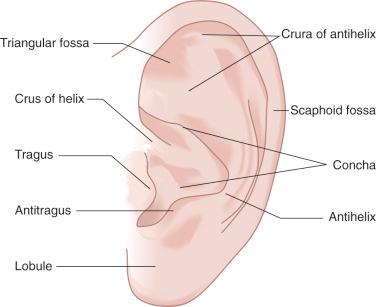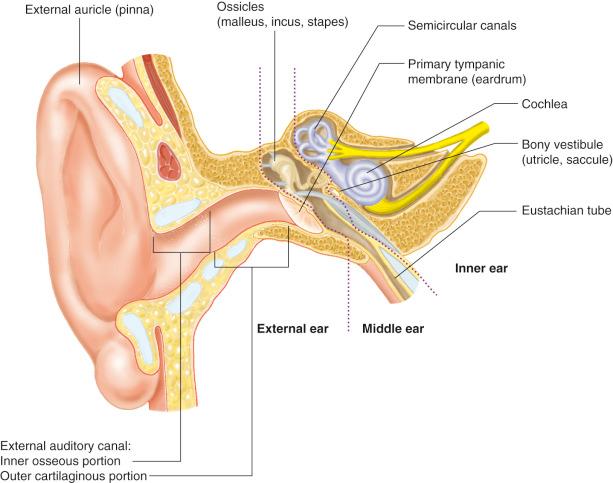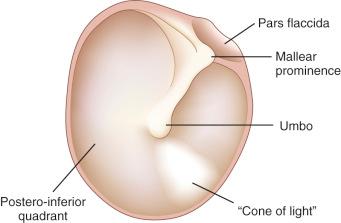Physical Address
304 North Cardinal St.
Dorchester Center, MA 02124
External ear develops from the first brachial groove.
Auricle (pinna) develops from the auricular hillocks, a group of six mesenchymal swellings, from the first and second branchial arches lying around the first branchial groove.
Mesenchymal structures of the auricle arise from the mesoderm of the first and second branchial arches.
Epithelium of the external auditory canal develops from the ectoderm at the dorsal end of the first branchial groove or cleft.
Tympanic membrane forms from the first and second branchial pouches and the first branchial groove:
Ectoderm of the first branchial groove gives rise to the epithelium on the external side.
Endoderm from the first branchial pouch gives rise to the epithelium on the internal side.
Mesoderm of the first and second branchial arches gives rise to the connective tissue lying between the external and internal epithelial surfaces.
Middle ear space develops from invagination of the first branchial pouch (pharyngotympanic tube) from the primitive pharynx.
Endoderm of the tubotympanic recess, a derivative of the first pharyngeal pouch, gives rise from its distal portion to the epithelium of the tympanic cavity and the mastoid antrum, and from its proximal portion to the epithelium of the auditory tube (eustachian or pharyngotympanic tube).
Middle ear ossicles have different derivations:
Malleus and incus develop from the mesoderm of the first branchial arch cartilage (Meckel cartilage).
Stapes develops from the mesoderm of the second branchial arch cartilage (Reichert cartilage).
Tensor tympani muscle, attached to the malleus, derives from the first branchial arch; stapedius muscle attached to the stapes, derives from the second branchial arch.
First of the three anatomic divisions of the ear to develop beginning toward the end of the first month of gestation.
Membranous labyrinth, including the utricle, saccule, semicircular ducts, and cochlear duct, arises from the otic vesicle (otocyst), an invagination from the surface ectoderm, which migrates into its position, losing its connection to the surface ectoderm.
Otic vesicle forms from the invagination of the surface ectoderm, located on either side of the neural plate, into the mesenchyme:
Invagination eventually loses its connection with the surface ectoderm.
Bony labyrinth including the vestibule, semicircular canals, and cochlea arises from the mesenchyme around the otic vesicle.
The ear can be considered as three distinct regions or compartments to include:
External ear
Middle ear and temporal bone
Inner ear



Consists of the auricle (pinna), external auditory canal (or meatus), and the tympanic membrane at the medial end of the auditory canal.
Outer portion of the external ear includes the auricle or pinna leading into the external auditory canal:
Skeleton of the auricle consists of a single plate of elastic cartilage conforming to the shape of the ear.
Lobule is the only part of the auricle that is devoid of skeletal support.
Cartilage of the auricle is continuous with that of the external auditory canal.
External auditory canal or meatus extends from the concha to its medial limit, which is the external aspect of the tympanic membrane:
Lateral portion of external canal wall consists of cartilage and connective tissue.
Medial portion of external canal wall consists of bone.
Cartilaginous part of the external auditory canal constitutes slightly less than half its total length.
Inconstant fissures referred to as the fissures of Santorini occur in the cartilage; these fissures may transmit infection from the canal to the parotid gland and superficial mastoid regions, or vice versa.
Bony part of the canal is formed by both the tympanic part and the petrous part of the temporal bone.
In adults, anterior and inferior walls of the cartilaginous canal are closely related to the parotid gland.
Anterior wall of the bony canal is closely related to the mandibular condyle, the posterior wall to the mastoid air cells, and the medial portion of the superior wall to the epitympanic recess.
Tympanic membrane (eardrum) is situated obliquely at the end of the external auditory canal sloping medially from above downward and from behind forward:
Tympanic membrane is a fibrous sheet interposed between the external auditory canal and the middle ear cavity.
Connective tissue interposed between these two layers consists of radiating fibers attached to the manubrium of the malleus that are reinforced peripherally by circular fibers
In the upper portion of the tympanic membrane there is a limited area where the connective tissue fibers are lacking; this area is referred to as the pars flaccida or Shrapnell membrane. In this area the tympanic portion of the temporal bone is deficient; this gap is referred to as the tympanic incisure or the notch of Rivinus, where the tympanic membrane attaches to the temporal bone.
Remainder of the tympanic membrane in which there are intact connective tissue fibers is referred to as the pars tensa.
Outer aspect of the tympanic membrane is concave:
Center of the concavity is referred to as the umbo, which is the strong point of attachment of the manubrium of the malleus to the tympanic membrane.
In otoscopic examinations of the tympanic membrane, the bright area of light reflection present downward and forward from the umbo is referred to as the “cone of light.”
Medial border:
Limited medially by the external aspect of the tympanic membrane
Middle ear or tympanic cavity lies within the temporal bone between the tympanic membrane and the squamous portions of the temporal bone laterally and the petrous portion of the temporal bone surrounding the inner ear medially.
Contents include:
Ossicles (malleus, incus, and stapes), ligaments of the ossicles, tendons of the ossicular muscles, eustachian tube, tympanic cavity proper, epitympanic recess, mastoid cavity, and the chorda tympani of the facial (VII) nerve
Extends from its tympanic ostium high on the anterior wall of the tympanic cavity to a nasopharyngeal ostium situated posterior to the inferior nasal concha.
Can be divided into an osseous portion and cartilaginous portion:
Osseous portion or canal has a bony wall and is the lateral or tympanic third of the tube.
Anteromedial two thirds has a cartilaginous and connective tissue wall and is referred to as the cartilaginous portion of the tube.
Cartilaginous and osseous tubes meet at an obtuse angle.
Eustachian tube is not straight but slightly S -shaped:
In adults:
Tympanic ostium is approximately 2 to 2.5 cm higher than is the nasopharyngeal end and runs downward, medially, and anteriorly to the nasopharynx.
Length of the tube in adults varies from 31 to 38 mm.
In infants:
Tube is shorter, relatively wider, and more horizontal in its course and therefore an easier pathway for infections ascending from the nasopharynx to the tympanic cavity.
Lateral (internal) border:
Internal aspect of the tympanic membrane and squamous portion of the temporal bone
Medial border:
Petrous portion of the temporal bone
Superior border (roof):
Delimited by the tegmen tympani, a thin plate of bone that separates the middle ear space from the cranial cavity
Inferior (floor):
Thin plate of bone separating the tympanic cavity from the superior bulb of the internal jugular vein
Anterior border:
Delimited by the thin plate of bone separating the tympanic cavity from the carotid canal housing the internal carotid artery
Posterior border:
Petrous portion of the temporal bone containing the mastoid antrum and mastoid air cells
Tympanic cavity communicates anteriorly with the nasopharynx by way of the eustachian (auditory or pharyngotympanic) tube and communicates posteriorly with the mastoid air cells by way of the aditus and mastoid antrum.
Become a Clinical Tree membership for Full access and enjoy Unlimited articles
If you are a member. Log in here